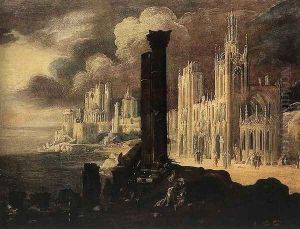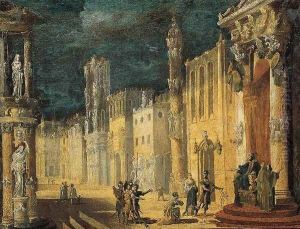Didier Barra (Monsu, Desiderio) Paintings
Didier Barra, also known as Monsu Desiderio or simply Desiderio, was a French Baroque painter who is known for his highly detailed and architecturally complex cityscape and landscape paintings. Born in 1590 in Metz, France, Barra is often associated with the group of artists active in Naples who painted startling, architectural visions, usually involving ruins.
Barra's work is characterized by its meticulous attention to detail and its fantastical, often eerie portrayal of ruins and imaginary landscapes, imbued with a sense of melancholy and desolation. His landscapes are typically devoid of human presence, or if figures are present, they are usually small and overwhelmed by the monumental scale of the architecture and the natural world.
Despite the nickname 'Monsu', which is a diminutive of the French 'monsieur' and was commonly applied to French artists working in Italy, there is little concrete evidence of Barra's presence in Naples. However, his stylistic choices strongly suggest the influence of Neapolitan art, particularly the work of artists such as Giovanni Battista Caracciolo and Battistello Caracciolo, who were instrumental in bringing Caravaggio's innovative realism to Naples.
The exact details of Barra's life and career are somewhat obscure, and many of his artworks were once attributed to other artists. It wasn't until the late 20th century that art historians began to properly attribute works to Barra and recognize his unique contribution to the world of art. His works can now be found in various art galleries and collections around the world.
Didier Barra's death is recorded in 1656, but his exact date of death is not well documented. His legacy continues to be appreciated for his unique vision and his ability to capture the interplay of architecture, light, and nature in his distinctive landscapes.

